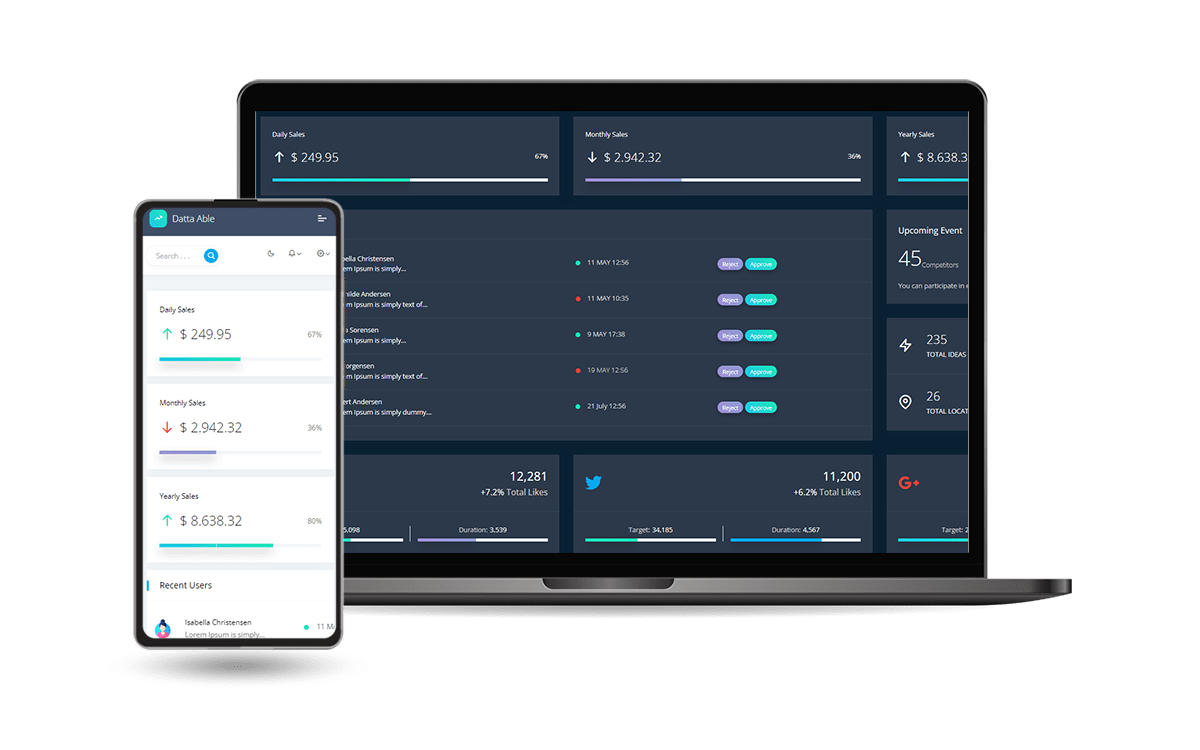Reference codebase used by AppSeed in all Flask Dashboard starters - the product uses an amazing design crafted by CodedThemes.
- 👉 Flask Boilerplate -
Product page - 👉 Flask Boilerplate -
LIVE App - 👉 Free Support via
Email&Discord
🚀 Built with App Generator, timestamp
2022-06-23 18:20
- ✅
Up-to-date dependencies - ✅
Database:SQLite, MySql- Silent fallback to
SQLite
- Silent fallback to
- ✅
DB Tools: SQLAlchemy ORM,Flask-Migrate - ✅
Authentication, Session Based,OAuthvia Github - ✅ Docker,
Flask-Minify(page compression) - 🚀
DeploymentCI/CDflow viaRender- Flask Datta Able - Go LIVE (
video presentation)
👉 Step 1 - Download the code
$ git clone https://github.com/app-generator/boilerplate-code-flask-dashboard.git $ cd boilerplate-code-flask-dashboard👉 Step 2 - Start the APP in
Docker
$ docker-compose up --build Visit http://localhost:5085 in your browser. The app should be up & running.
The meaning of each variable can be found below:
DEBUG: ifTruethe app runs in develoment mode- For production value
Falseshould be used
- For production value
ASSETS_ROOT: used in assets management- default value:
/static/assets
- default value:
Download the code
$ git clone https://github.com/app-generator/boilerplate-code-flask-dashboard.git $ cd boilerplate-code-flask-dashboardInstall modules via
VENV
$ virtualenv env $ source env/bin/activate $ pip install -r requirements.txtSet Up Flask Environment
$ export FLASK_APP=run.py $ export FLASK_ENV=developmentStart the app
$ flask run // OR $ flask run --cert=adhoc # For HTTPS serverAt this point, the app runs at http://127.0.0.1:5000/.
Install modules via
VENV(windows)
$ virtualenv env $ .\env\Scripts\activate $ pip install -r requirements.txt Set Up Flask Environment
$ # CMD $ set FLASK_APP=run.py $ set FLASK_ENV=development $ $ # Powershell $ $env:FLASK_APP = ".\run.py" $ $env:FLASK_ENV = "development"Start the app
$ flask run // OR $ flask run --cert=adhoc # For HTTPS serverAt this point, the app runs at http://127.0.0.1:5000/.
By default, the app redirects guest users to authenticate. In order to access the private pages, follow this set up:
- Start the app via
flask run - Access the
registrationpage and create a new user:http://127.0.0.1:5000/register
- Access the
sign inpage and authenticatehttp://127.0.0.1:5000/login
The project is coded using blueprints, app factory pattern, dual configuration profile (development and production) and an intuitive structure presented bellow:
< PROJECT ROOT > | |-- apps/ | | | |-- home/ # A simple app that serve HTML files | | |-- routes.py # Define app routes | | | |-- authentication/ # Handles auth routes (login and register) | | |-- routes.py # Define authentication routes | | |-- models.py # Defines models | | |-- forms.py # Define auth forms (login and register) | | | |-- static/ | | |-- <css, JS, images> # CSS files, Javascripts files | | | |-- templates/ # Templates used to render pages | | |-- includes/ # HTML chunks and components | | | |-- navigation.html # Top menu component | | | |-- sidebar.html # Sidebar component | | | |-- footer.html # App Footer | | | |-- scripts.html # Scripts common to all pages | | | | | |-- layouts/ # Master pages | | | |-- base-fullscreen.html # Used by Authentication pages | | | |-- base.html # Used by common pages | | | | | |-- accounts/ # Authentication pages | | | |-- login.html # Login page | | | |-- register.html # Register page | | | | | |-- home/ # UI Kit Pages | | |-- index.html # Index page | | |-- 404-page.html # 404 page | | |-- *.html # All other pages | | | config.py # Set up the app | __init__.py # Initialize the app | |-- requirements.txt # App Dependencies | |-- .env # Inject Configuration via Environment |-- run.py # Start the app - WSGI gateway | |-- ************************************************************************Flask Dashboard Boilerplate - Open-source starter generated by App Generator.
